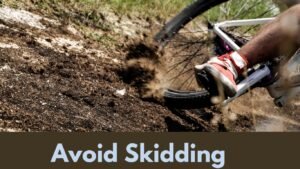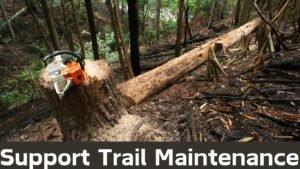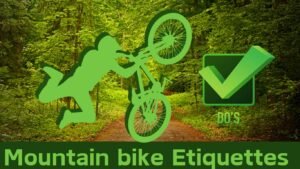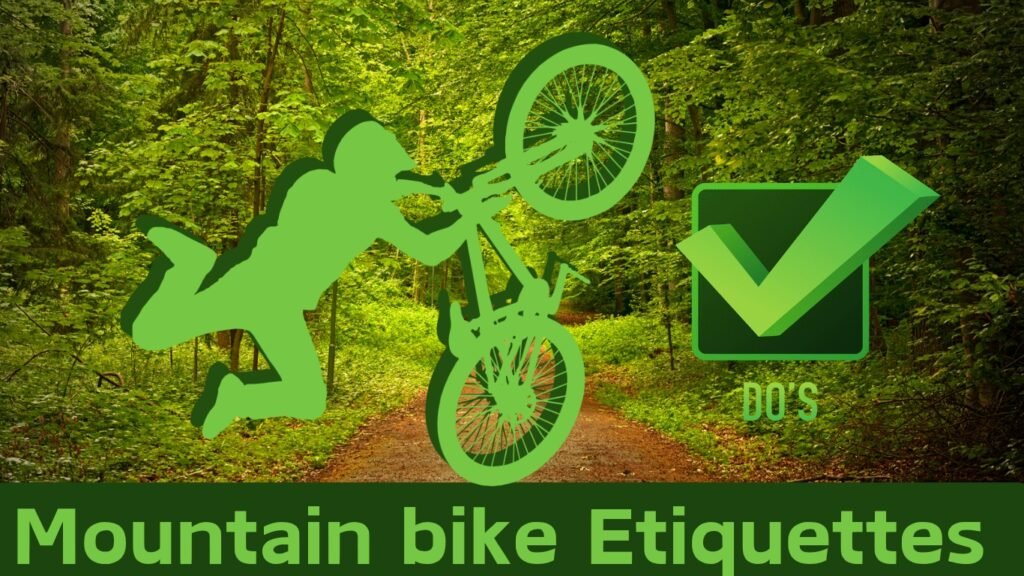Mountain biking is a nice way to spend time with nature and have fun, but many people overlook basic mtb etiquettes and rules without even thinking; it’s our (bikers) responsibility to keep the mountain bike trails clean and maintain it for everyone’s enjoyment
Even you won’t like it if somebody passes through you aggressively, startling you or even causing a collision.
That’s why in this guide, we will discuss 15 mountain bike trail etiquette that every mountain biker should follow to keep the biking community’s environment better.
Also read: Most Scenic mountain bike trails in the world
1. Yield to Hikers and Horses

For mountain bikers, it’s pretty common to encounter other hikers and horseback riders. Therefore, you want to give them enough space if they are passing by you.
Sometimes, 1,000-pound animals can get scared by your bike; that’s why you want to slow down the bike and stand aside if you see a horse passing by you.
Many horses do not like a fast-moving object passing by them as it makes them feel like mountain bikers are predators.
Also read: How to Find a Local Mountain Bike Trails Near You
2. Announce Your Presence

When you are overtaking a hiker, runner, or slow rider, let them know about your presence.
You can even say “On Your Left” or “Coming Up”, or you can simply use your mountain bike’s bell, especially when you are on a tight or blind turn where you can’t see what’s ahead.
The bell sounds, or your voice will give others a heads-up to adjust accordingly.
Many times, your voice might not be enough, so you will want to use your bike’s bell as it’s louder.
Also read: Mountain Bike Maintenance Tips (Repair at Home)
3. Ride in Control—Always
Would you like it if you were riding on a simple road and a speeding car passed closer to you?
You always want to ride in control, especially on turns, because you can wipe out, which is dangerous for you, even if you do not crash.
It’s dangerous for other riders or hikers who might be coming from the other side.
Most mountain bike trails, especially those designed for advanced riders, have unexpected obstacles, like roads, rocks, and even wildlife (like bears).
So you want to ride in control (at a limited speed), especially when you are in a crowded area.
Most hikers and equestrians also do not like fast-moving bikes, as they are afraid that the bike might collide with them, which can cause serious mountain bike injury.
4. Stick to Open Trails

Upon reaching a mountain bike trail, if you see it is closed, then do not try to create a shortcut; just avoid riding there.
That trail might be damaged, and authorities would be working on it.
If you ride on that, it can increase erosion and even lead to trail closure. You want to preserve the environment.
So, you only need to ride on those open trails. To find out this, you can use apps like Trailforks or MTBProject. You can download it from the App Store or even use the app’s website.
These MTB platforms will give you a map, photos, and reviews about a trail and also will tell you about the weather conditions.
When you ride on open trails, you ensure that you are not contributing to trail degradation.
Thus, you are preserving nature’s beauty for other bikers.
5. Respect Trail Closures
Do not even think of riding on a trail that is closed or under maintenance.
As I mentioned earlier, you can use apps like Trailforks or MTBproject to find out the open or closed status of that trail.
If you really want to enjoy that day (the same day when you find the trail close), you can find alternative routes to ride your bike.
Most trails are closed at a specific time for maintenance work or if they get too muddy or wet after a heavy rain.
Also read: Sedona Mountain Biking Review: Is it Worth visiting?
6. Uphill Riders Have the Right of Way
Climbing trails takes a lot of effort, but if somebody stops mid-climb, it breaks momentum.
So, if you are descending and you see someone is climbing, then pull over them and allow them to pass first.
Most uphill riders will appreciate this simple gesture when you give them enough way without allowing them to break their momentum.
Also read: How to stay safe in Remote mountain biking trails
7. Don’t Skid Your Tires

Skidding looks cool, but it also tears up trails and creates erosion problems.
That’s why you should avoid this, and instead of that, you can learn some proper braking techniques to maintain traction and control.
You don’t want to leave any scar on the trail to preserve it for other riders.
Besides, this skidding also leads to rust creation over time. The rust makes the trail dangerous and hard to ride.
I suggest you brake smoothly by applying gentle pressure on both brakes, rear and front.
Also read: 4 Week Training program for Beginner Mountain Biker
8. Leave No Trace

Many mountain bikers leave an energy bar wrapper or a water bottle on the trail, which is not good.
That’s why you always want to bring it back home or put this trash in a trashcan.
Even if you find a wrapper that is not yours, you still want to pick it up and put it in the right place to keep the trail better and clean for everybody.
I suggest you use reusable bottles to bring water and biodegradable products. It helps to minimize all this impact.
Also read: Safety tips for Mountain Bikers
9. Pass Carefully and Politely
Passing can be a little tricky on narrow trails.
That’s why you want to announce your intention clearly. And give other people some time to move aside.
Besides this, if you see somebody who is going to pass by you who is going faster, then do not take it personally and allow them to go ahead of you.
It will avoid any unnecessary tension and will ensure other bikers have a good flow.
You can then step aside or slow down. It’s a polite and better way that every rider needs to follow.
10. Ride in Groups Responsibly

Sometimes, riding a mountain bike in a group is more enjoyable than riding solo, but it can also clog up trails.
That’s why you want to keep your group small and tell everybody about some basic mountain bike trail etiquette rules before heading out.
While riding in a group, if there is a slower rider, and you wait for him or her, you want to stand aside and allow others to pass to avoid bottlenecks.
This simple thing will keep the traffic flow smooth and prevent frustrating delays for other riders.
Besides this, you want to be mindful of how your group impacts other riders, especially on busy trails, on weekends, or other special days.
One more tip for your group is that all group members should stay together instead of spreading out too far because it can make it difficult for others to pass or navigate the trail; plus, it’ll also break your momentum when you wait for a rider again and again.
If you are all (group members) riding together while occupying all the space, it would be better if you all ride in a line.
Even if you are not in a line, then you still need to keep some space for other riders.
Also read: Pre Ride Checklist for MTB Riders
11. Avoid Loud Music
Listening to music while riding or singing songs together in a group makes the ride more fun.
But listening in loud or singing too loudly is not good as it affects wildlife and also annoys other people who don’t want to listen to that music.
Always use earbuds if you really want to hear music.
But make sure to keep one ear open for safety, plus keep the volume low to ensure that you can hear your surroundings quickly and react as soon as possible.
12. Repair Damage If You Can
If you accidentally damage a trail like dislodged rocks or break any branch, then try to fix that.
You can also report the trail manager for a major issue or even your riding group to be careful about that.
Because it’s your duty as a rider to preserve that trail and keep it in good condition for other riders, every big and small effort counts to maintain the trail’s quality for a safe ride for everyone.
13. Support Trail Maintenance

Trails don’t maintain themselves. There are many volunteers who keep them in shape.
Especially during weekends, they clean trails, clear bushes, fix rust, and build features.
Therefore, you can also join a local group or donate some money for trail maintenance.
By doing so, you will contribute to trail maintenance and the long-term sustainability of that trail system.
14. Yield at Trail Intersections

Whenever you cross a path to another with another trail, then slow down the speed and look both ways.
By doing so, you can prevent a collision while keeping the traffic flow smooth.
Plus, you should be aware of other riders, such as hikers or horseback riders. They might also come from any direction.
15. Be Friendly—Say Hi!
While riding on your mountain bike, if you see somebody passing by you or you see a random biker coming from the front, you can simply say “Hi/Hello”, “Have A Nice Day”, or “A Nice Day For A Ride”, something like this.
It’s a good way to build a positive vibe on the trail. Actually, mountain biking is a community, and a friendly attitude will make everyone’s day.
And inspire them to stick with this beautiful sport, which is not just for having a good time but also for your health.
Final Thoughts
Now that you know some of the most important mountain biking etiquette and rules. So it’s not about being perfect; it’s about being mindful.
It’s okay if you have forgotten something like an energy bar wrapper by mistake or you left a skid mark mistakenly. It’s okay, but you should never do it intentionally.
You want to keep the mountain trail’s environment good for all riders.
These 15 mountain bike etiquettes are not just for bikers, but they apply to all hikers, runners, equestrians, etc.
What is the proper way to yield on a mountain biking trail?
Well, it depends on the specific trail. But generally, uphill riders yield downhill riders.
It’s because downhill riders do not have much control over their speed and momentum.
So, if you are on a descending trail, you want to be prepared to slow down and yield to other riders if you encounter one.
Most of the time, uphill riders struggle with climbing. Therefore, a rider who is at a faster speed should slow down looking at the slower rider.
Plus, it’s also good to communicate clearly or using a bell or a friendly phrase like “Passing On Your Left”.
How can I minimize my impact on the trails?
You want to stay established on the trails to protect the sensitive trail ecosystem. So, you first want to avoid creating any new lines or cutting switchbacks.
Plus, you can also avoid riding in muddy or wet conditions.
Besides this, you have to be mindful even if you are allowed to ride there.
If you ever encounter obstacles like fallen branches or rocks, you should move them off the trail. It’s good mountain bike trail etiquette.
What should I do if I encounter a hiker or equestrian on the trail?
Being a mountain biker, you need to yield to other trail users, including hikers and horses.
So you want to slow down your speed because, most of the time, hikers and equestrians do not like fast-moving objects.
A hiker may understand the presence of a bike, but a horse might get startled.
Besides this, you also want to greet others in a friendly way, or you can even stop completely and let the horse pass first.
But when you are greeting someone or talking to the horse rider, make sure you talk politely and then move slowly.
What is the appropriate bell etiquette for mountain biking?
A bell is a nice way to announce your presence to other people on the trail.
However, you want to use it in advance to approach others, especially in the blind corner or in a limited visibility area.
Do not constantly ring the bell; it’s really annoying for most riders, hikers, and horses. You just want to use that bell to alert others about your presence.

Ali is the founder of Mountain Bike Insider and an passionate rider with years of hands-on experience in mountain biking. From testing gear to exploring trails, Ali writes based on real riding knowledge to help others make smart, safe, and enjoyable biking choices. Every guide is built on research, personal use, and a passion for the sport.







